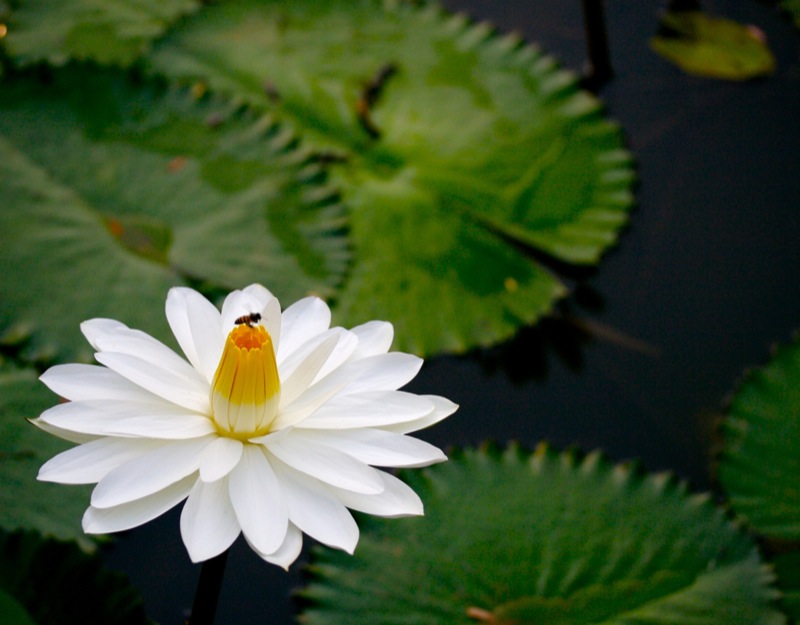
Features
Fish Nutrition
Nutrition & Feed products
Sustainability
Wanted: Fishmeal replacement
With fishmeal accounting for a huge chunk of fish diet cost, there is a continuous search for cheap alternative ingredients
September 27, 2019 By Ruby Gonzalez
 Nymphaea lotus (Photo by xmatt - https://www.flickr.com/photo_zoom.gne?id=398390464&context=set-72157594549571030&size=o, CC BY 2.0, https://commons.wikimedia.org/w/index.php?curid=1874002)
Nymphaea lotus (Photo by xmatt - https://www.flickr.com/photo_zoom.gne?id=398390464&context=set-72157594549571030&size=o, CC BY 2.0, https://commons.wikimedia.org/w/index.php?curid=1874002)In Nigeria, it was reported that fish farmers who couldn’t afford fishmeal have resorted to using bread crumbs and other cheap carbohydrate sources as feeds, which result in poor-quality fish.
Blood meal is another cheap alternative source of protein. To find out its impact on the key performance indicators of the fish, a study was conducted by researchers from the Ajuru University of Education.
John Amadi and his team embarked on determining how several diets containing various percentage replacements affected the increase in length and weight of North African catfish (Clarias gariepinus). Carcass composition was likewise evaluated.
Results of the best trial diet in Nigeria for Carias gariepinus fingerling fared better than the control group diet of pure fishmeal.
“The present study revealed that [diet with 30 per cent replacement] proved to be most conducive for rearing Clarias gariepinus fingerlings. And it was the best alternative in comparison with [control diet] because it gave rise to the best growth rate and size increase,” the authors cited in, “Blood meal as substitute for fish meal in the diet of Clarias gariepinus fingerlings: carcass analysis and condition factors,” published in the International Journal of Fisheries and Aquatic Research.
The trial diets included substitutions of 10 to 30 per cent blood meal at five per cent increments.
Lotus leaf meal
In Cote d’Ivoire, a researcher found potential in the Nymphaea lotus leaf meal (NLM). Up to 20 per cent of NLM can be incorporated in the diet of African catfish with no adverse effects on growth performance, feed utilization, and survival rate, according to a study conducted by Athanase Otchoumou, teacher-researcher at the University Felix Houphouet Boigny.
“To sum up, the present study is preliminary work for future studies evaluating the dietary inclusion of NLM in aquatic feeds as a promising cheap source of protein,” cited Otchoumou in, “Growth performance of Heterobranchus longifilis, (Valenciennes, 1840) Fingerlings Fed with Nymphaea lotus (Linné, 1753),” published in the Journal of Agricultural Studies. The research studied the effects of including Nymphaea lotus leaf meal in the diet of African catfish (Heterobranchus longifilis) fingerlings.
Inclusion of the NLM was done at 10, 20, 30 and 40 per cent of the total fish diet.
Retarded growth of fishes was observed above the optimum level of 20 per cent of plant proteins. Otchoumou said that this level could be increased if the lotus leaves were previously treated to reduce the anti-nutritional factors.
Fermented compound protein
A study resulting from a multi-sectoral collaboration in China cited that fermented compound protein may be one kind of potential protein sources for Chinese mitten crab, Eriocheir sinensis.
“The results showed that fermented protein could significantly increase mean weight gain, crab size and total yield compared with control group. Moreover, the mean weight of male crabs and the number of large-sized male crabs improved over those of the control group,” said Jiying Yu and his team. They represent universities, private companies and a government agency in Nanjing, Beijing and Wuxi.
The study, which was published in ScienceDirect’s Aquaculture and Fisheries journal, focused on an alternative feeding method and sought ways to reduce the use of trash fish in crab farming, measured growth performance and assessed the biochemical changes in the edible parts of crab.
Trash fish supplemented with corn, wheat and pea is the common feed for crab in Jiangsu province, where the experiment was conducted. Stakeholders, however, have started looking for other protein sources. In addition to the fact that trash fish supply is falling, it has been identified as a pollutant in aquaculture water.
The experiment covered the process from stocking the ponds with young crabs to harvesting mature crab. The control group was fed with small trash fish, pea and wheat grain. The experimental group was fed with small trash fish and formulated pellet feed, which contained fermented compound protein feed.
Print this page
Advertisement
- Seafood sustainability on the UN General Assembly agenda
- BC producer to grow Coho salmon with cannabis





